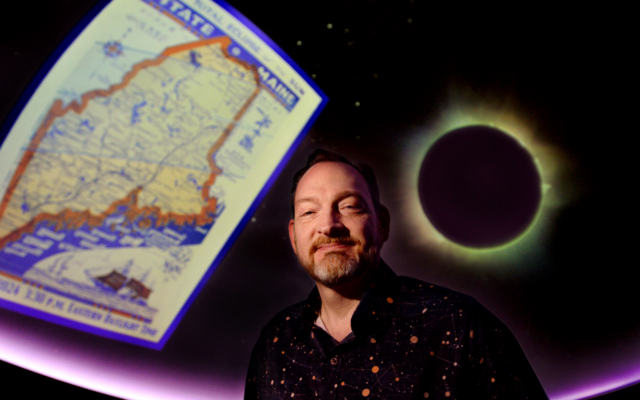
How a Maine astronomer is preparing for the ‘full-body experience’ of a total eclipse
By Kathleen O’Brien, Bangor Daily News Staff
Shawn Laatsch has seen five total solar eclipses in his life, but he believes each time seeing the natural phenomenon is just as spectacular as the first.
“The temperature drops, birds and animals pay attention, the winds die down, it’s really a full-body experience,” said Laatsch, director of the Versant Power Astronomy Center and Jordan Planetarium at the University of Maine. “When you experience it, you understand why ancient people feared them.”
A solar eclipse happens when the moon passes between the earth and sun. On April 8, a large portion of Maine will fall in a 155-mile-wide “path of totality” — a shadow from Texas to Maine in which the moon will completely obscure the sun for two to four minutes.
Next month, Laatsch will be in Jackman to capture photographs of the eclipse as part of a research project called the Citizen Continental-America Telescope Eclipse.

CENTER DIRECTOR — Shawn Laatsch, director of Versant Power Astronomy Center at the University of Maine, is photographed in the planetarium. A total solar eclipse and a map of Maine illustrating the eclipse’s path of totality on April 8 are displayed above him.
The project, which is funded by NASA and the National Science Foundation, established 35 stations from Texas to Maine that fall on the centerline of the eclipse’s path of totality. Each station will use a special polarized camera to capture the sun’s corona — the outermost portion of the sun’s atmosphere — that’s visible only during a total solar eclipse.
When the images from across the country are strung together, they will show a 60-minute video of how the sun’s corona changes over the course of the eclipse, Laatsch said.
Researchers are interested in studying this because the sun’s corona throws protons and electrons into space, where they travel toward Earth and can impact our power grids, astronauts aboard the International Space Station, and cause the Northern Lights.
Though all of Maine will be able to see the upcoming eclipse to some degree, Laatsch said he hopes people make an effort to witness it from within the path of totality because of how striking the spectacle is.
“The difference between 99 percent and 100 percent totality is like the difference between seeing a lightning bug and getting struck by lightning,” he said.
Solar eclipses occur every year to 18 months, but Laatsch said someone has to be in “exactly the right spot” to witness it. Because of this, he has traveled to Australia, Montana, Libya and the Black Sea to witness and research total solar eclipses in his career. He saw his first when he was 9 years old on vacation with his family in Canada.
“Each time you see an eclipse, it’s a little different, but it never gets old because each one is special,” Laatsch said.
It is rare for a solar eclipse’s path of totality to fall in Maine. The last time it happened was 1963, and it won’t happen again until 2079.
The April 8 eclipse will come after months of training Laatsch got to capture the eclipse from Maine, as well as countless events Laatsch led to teach Mainers about eclipses and how to prepare for them.
In March alone, Laatsch is scheduled to conduct more than 30 community events centered around the eclipse. Some of those events are for local school children, while others are for the general public. Laatsch has also led workshops for local teachers on how they can incorporate the eclipse into their curriculum.
“The last several months have been all eclipse, all the time,” Laatsch said. “But I don’t ever get bored by it. One of the things I love most is sharing astronomy with people.”
When he’s not preparing for a once-in-a-lifetime eclipse, Laatsch leads regular programming at the planetarium. He said it reminds him of his first astronomy job in high school when he worked at his local planetarium in Wisconsin.
“I’ve always enjoyed looking at the night sky,” Laatsch said. “When I was young, I remember my grandfather showing me the Big and Little Dipper. After that, I remember going to a planetarium when I was in second grade and that got me excited about astronomy.”